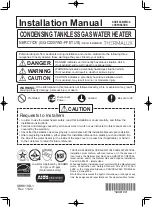
Electrical installer
Installation, use and maintenance manual – G gas unit heater
23
4
system must be made at atmospheric pressure, i.e.
by dripping into a siphoned container connected
to the sewerage system.
Figure 3.9
Detail of the installation of the condensate discharge
siphon
A Condensate discharge connection (to be provided by the installer)
B
Upper seal
A
B
3.4.3
Flue gas condensate discharge manifold
To make the condensate drain manifolds:
▶
Size the ducts for maximum condensation capacity
(Table 1.2
▶
Use plastic materials resistant to acidity pH 3-5.
▶
Provide for min. 1% slope, i.e. 1 cm for each m of the
length (otherwise a booster pump is required).
▶
Prevent freezing.
4
ELECTRICAL INSTALLER
4.1
WARNINGS
General warnings
Read the warnings in Chapter III
p. 4, provid-
ing important information on regulations and on
safety.
Compliance with installation standards
Installation must comply with applicable regula-
tions in force, based on the installation Country
and site, in matters of safety, design, implementa-
tion and maintenance of electrical systems.
Installation must also comply with the manufactur-
er's provisions.
Live components
After placing the appliance in the final position,
and prior to making electrical connections, ensure
not to work on live components.
Earthing
The appliance must be connected to an effective
earthing system, installed in compliance with reg-
ulations in force.
It is forbidden to use gas pipes as earthing.
Cable segregation
Keep power cables physically separate from signal
ones.
Do not use the power supply switch to turn the
appliance on/off
Never use the power supply switch to turn the ap-
pliance on and off, since it may be damaged in the
long run (occasional blackouts are tolerated).
To turn the appliance on and off, exclusively use
the suitably provided control device.
4.2
ELECTRICAL SYSTEMS
Electrical connections provide:
A.
Power supply (Paragraph 4.3
p. 23).
B.
Control system (Paragraph 4.4
How to make connections
All electrical connections must be made on the electronic
control board in the electrical panel of the unit:
1.
Ensure the appliance is not live.
2.
To access the electrical board open the door on the
right side of the unit.
3.
Insert cables through cable gland (detail 3 on dimen-
sional diagrams, Paragraph 1.2
p. 8).
4.
Identify the appropriate connection terminals.
5.
Make the connections.
6.
Close the door.
4.3
ELECTRICAL POWER SUPPLY
4.3.1
Power supply line
Provide (by the installer) a protected single phase line
(230 V 1-N 50 Hz) with:
▶
H05 VVF 3x1,5 mm
2
type cable with a maximum exter-
nal diameter of 12 mm.
▶
Bipolar disconnector with minimum contact opening
of 3 mm.
















































